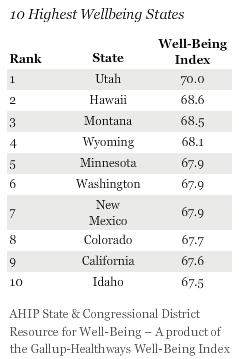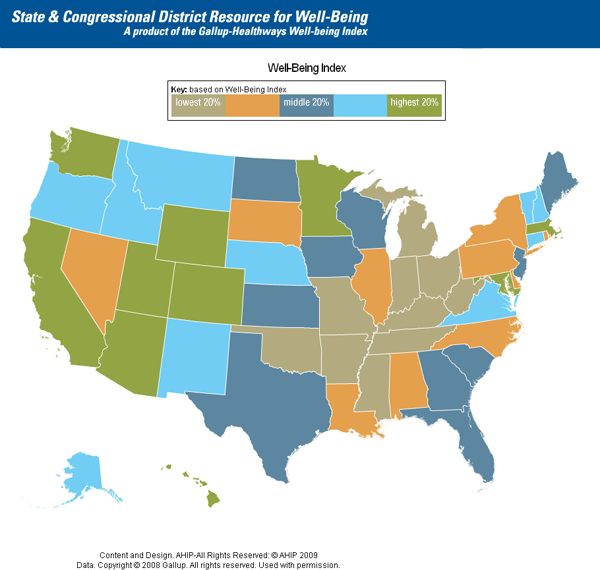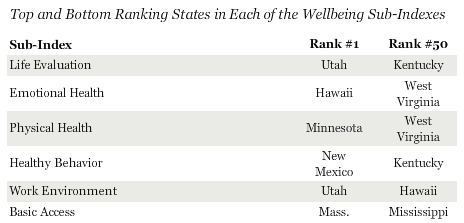Editor's Note: This story has been updated to reflect Gallup's re-estimate of its Gallup-Healthways Well-Being Index and Life Evaluation Index data from January 2008 to April 2009. .
WASHINGTON D.C. -- Utah, Hawaii, and Montana top the nation in well-being in an analysis of more than 350,000 interviews conducted in 2008. Mississippi, Kentucky, and West Virginia have the lowest well-being ratings.


These new, state-level data are the results from The AHIP State and Congressional District Resource for Well-Being. The Well-Being Index score for the nation and for each state is an average of six sub-indexes, which individually examine life evaluation, healthy behaviors, work environment, physical health, emotional health, and access to basic necessities. The questions in each sub-index are asked nightly of 1,000 national adults, aged 18 and older.
The Well-Being Index national average for 2008 is 65.9, with each point (1.0) representing approximately 2.2 million people nationally. In terms of the total population in the United States, this means that approximately 145 million people aged 18 and older have favorable well-being. Across all the states, well-being varies by a range of eight points, thus even in the lowest-ranked states, there are a majority of citizens who have favorable well-being.
Mapping well-being scores across the country, a clear pattern emerges with higher well-being states located primarily in the West and lower well-being states clustered in the Midwest and the South. Standing out among its high-ranking western counterparts is Nevada, with a slightly below average well-being score and a rank of 44th.

In addition to the overall well-being score, the states are also ranked on each of the six sub-indexes. Utah takes the top spot in both work environment and in life evaluation. Minnesotans report the best physical health in the nation, while New Mexico is first in healthy behaviors. Hawaii has the highest emotional health in the country and Massachusetts comes out on top in terms of access to basic necessities.

On the other side of the ledger, West Virginia has the lowest score on two of the six sub-indexes -- emotional health and physical health. Kentucky ranks last on healthy behaviors and in life evaluation, and Mississippi is at the very bottom in terms of access to basic necessities.
States in the top tier in overall well-being are not necessarily the highest ranking states in each of the six sub-indexes. Hawaii, for instance, does rank high on five of the six sub-indexes, but reports the lowest quality work environments out of all 50 states. On the flipside, certain bottom ranked states in overall well-being shine in select sub-indexes. All told, in order for the Well-Being Index national average to increase in 2009, every state will need to make significant improvements in at least one sub-index area.
For more information on what each sub-index comprises, see page 2.
Editor's Note: An update to the national Well-Being Index score for 2008 is reflected in this article.
Survey Methods
Results are based on telephone interviews with more than 350,000 national adults, aged 18 and older, conducted in 2008 as part of ���۴�ýPoll Daily tracking. For results based on the total sample of national adults, one can say with 95% confidence that the maximum margin of sampling error is ±1 percentage point.
Interviews are conducted with respondents on land-line telephones (for respondents with a land-line telephone) and cellular phones (for respondents who are cell-phone only).
In addition to sampling error, question wording and practical difficulties in conducting surveys can introduce error or bias into the findings of public opinion polls.
About the Gallup-Healthways Well-Being Index™
The Gallup-Healthways Well-Being Index is the first and largest survey of its kind, with 1,000 calls a day, seven days a week. It is the official statistic for well-being in America, giving a daily measure of people's well-being at the close of every day based on the World Health Organization (WHO) definition of health as not only the absence of infirmity and disease but also a state of physical, mental and social well-being. The Well-Being Index will be a daily measure determining the correlation between the places where people work and the communities in which they live, and how that and other factors impact their well-being. Additionally, The Well-Being Index will increase the understanding of how those factors impact the financial health of corporations and communities. For additional information, go to .
The Gallup-Healthways Well-Being Index
The Gallup-Healthways Well-Being Index includes six sub-indexes:
|
|
Life Evaluation:
The Life Evaluation Index includes a self-evaluation of two items (present life situation and anticipated life situation five years from now) using the Cantril Self-Anchoring Striving Scale with steps from 0 to 10, where "0" represents the worst possible life an "10" represents the best possible life. Taken together, respondents are then classified as "thriving," "struggling," or "suffering".
Physical Health
The Physical Health Index includes nine items: sick days in the past month, disease burden, health problems that get in the way of normal activities, obesity, feeling well-rested, daily energy, daily colds, daily flu, and daily headaches.
Emotional Health
The Emotional Health Index includes 10 items: smiling or laughter, learning or doing something interesting, being treated with respect, enjoyment, happiness, worry, sadness, anger, stress, and diagnosis of depression.
Healthy Behavior
The Healthy Behavior Index includes four items: smoking, eating healthy, weekly consumption of fruits and vegetables, and weekly exercise frequency.
Work Environment
The Work Environment Index includes four items: job satisfaction, ability to use one's strengths at work, supervisor's treatment (more like a boss or a partner), and is it an open and trusting work environment.
Basic Access
The Basic Access Index includes 13 items: access to clean water, medicine, a safe place to exercise, affordable fruits and vegetables; enough money for food, shelter, healthcare; having health insurance, having a doctor, having visited a dentist recently; satisfaction with the community, the community getting better as a place to live, and feeling safe walking alone at night.
